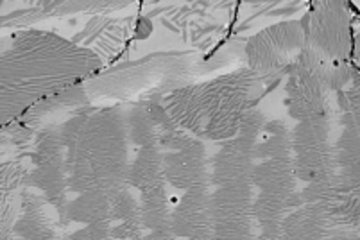All genres
321.
Talk
Konstitutionsuntersuchungen im System Nb-Cr-Al: Erste Ergebnisse und weitere Planungen. Workshop: The Nature of Laves Phases VII, MPI für Metallforschung Stuttgart, Germany (2006)
322.
Talk
Iron-Silicon Alloys with 3.5, 4.5 and 5.5 wt.% Si Processed under Microgravity. TEMPUS Parabolic Airplane Flight 2006 Meeting, DLR Bonn, Germany (2006)
323.
Talk
The Nature of Laves Phases – A Critical Assessment of the Current Knowledge on Structure and Stability of Laves Phases. Workshop "The Nature of Laves Phases VI, MPI für Chemische Physik fester Stoffe, Dresden, Germany (2006)
324.
Talk
Iron-Silicon Alloys with Optimized Microstructure for the Improvement of Soft Magnetic Steel Sheets. Meeting “TEMPUS Parabolic Airplane Flight 2005”
, DLR Bonn, Germany (2006)
325.
Talk
Strengthening of Fe–Al-Based Alloys for High-Temperature Applications. 3rd Disc.Meeting on the Development of Innovative Iron Aluminium Alloys, Mettmann-Düsseldorf, Germany (2006)
326.
Talk
Initial Stages of Oxide Growth on Fe–Al Alloys. 3rd Disc.Meeting on the Development of Innovative Iron Aluminium Alloys, Mettmann-Düsseldorf, Germany (2006)
327.
Talk
DTA Studies on the Fe–Al Phase Diagram. 3rd Disc.Meeting on the Development of Innovative Iron Aluminium Alloys, Mettmann-Düsseldorf, Germany (2006)
328.
Talk
Iron-Aluminium-Base Alloys for Structural Applications at High Temperatures: Needs and Prospects. EUROMAT 2005, Prague, Czech Republic (2005)
329.
Talk
Characterization of Thin Oxide Layers Grown on Fe–15at.%Al. EUROCORR 2005, Lisbon, Portugal (2005)
330.
Talk
Experimental Investigations of Structure Type Variations of Laves Phases. International Conference on "Modern Materials Science: Achievements and Problems", Kiev, Ukraine (2005)
331.
Talk
Phase Relations between Laves Phases in Transition Metal Systems - Case Studies: Co–Nb, Al–Co–Nb, Cr–Ti, Fe–Zr, Al–Fe–Zr. EUROMAT 2005, Prague, Czech Republic (2005)
332.
Talk
Phase Equilibria in the Al–Co–Nb Ternary System in the Vicinity of the Laves Phases. CALPHAD XXXIV, Maastricht, The Netherlands (2005)
333.
Talk
Untersuchung des Erstarrungsgefüges einer unter Schwerelosigkeit erschmolzenen intermetallischen TiAl-Legierung. Workshop "Entwicklung der Basis - Erkennen der Perspektiven", Materialwissenschaften und mg-Forschung, MPI für Eisenforschung, Düsseldorf, Germany (2005)
334.
Talk
Investigation of the Phase Equilibria in the Al–Co–Nb System. Preliminary Results. International Workshop "Laves Phases IV", MPI für Eisenforschung, Düsseldorf, Germany (2005)
335.
Talk
Nb–Co Diffusion Couples with Sequences of Laves Phases Investigated by EBSD. International Workshop "Laves Phases IV", MPI für Eisenforschung, Düsseldorf, Germany (2005)
336.
Talk
Investigation of the Phase Equilibria in the Al–Co–Nb System using Liquid-Solid Diffusion Couples. Preliminary Results. COST 535 Diffusion Couple Workshop, MPI für Eisenforschung, Düsseldorf, Germany (2004)
337.
Talk
Identification of Sequences of Phases by EBSD in Nb–Co Diffusion Couples. COST 535 Diffusion Couple Workshop, MPI für Eisenforschung, Düsseldorf, Germany (2004)
338.
Talk
Anfangsstadien der Oxidation von intermetallischen Fe–Al Phasen. 38. Metallographietagung der DGM, Bochum, Germany (2004)
339.
Talk
Oxidation Behaviour of Fe–Al Alloys Analysed Using In- and Ex-situ Techniques. EUROCORR 2004, Nice, France (2004)
340.
Talk
Laves Phase Polytypism in the Co–Nb System. TOFA 2004 - Discussion Meeting on Thermodynamics of Alloys, Wien, Austria (2004)











